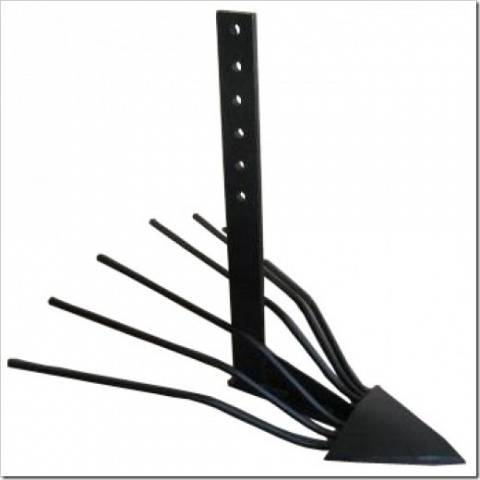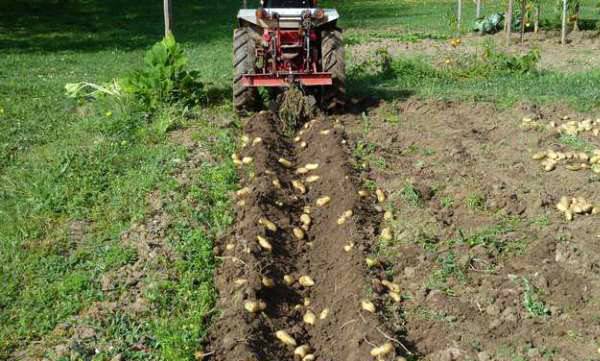Content
Growing a good potato crop is only half the battle. There is no less difficult work ahead related to the harvesting of tubers. Dig potatoes heavy. If the summer cottage garden is no more than two or three acres, then you can handle it with a bayonet shovel. On large areas, digging potatoes with a walk-behind tractor greatly simplifies the harvesting process. The technique itself will cope with digging out the tubers. You just have to operate a motor-cultivator and harvest a crop for it.
Benefits of using garden equipment
Gardeners who have poorly mastered the technique are afraid to dig potatoes with walk-behind tractors for fear of harming the crop. In fact, these fears are not in vain. If the machine with the additional equipment is incorrectly set up, the harvest will end in cut tubers.
The simplest potato digger is bent at a slight angle. When does it start harvesting potatoes, the tilt of the plow is adjusted until the optimum penetration depth is achieved. Correctly adjusted technique easily drives through the garden, and very rarely cuts the tubers.
When we dig potatoes walk-behind tractor, we get the following advantages:
- First of all, digging potatoes with a walk-behind tractor is much easier than doing it manually. Moreover, not only energy is saved, but also your own time.
- Only harvesting potatoes with a walk-behind tractor allow us to extract the crop from the ground as quickly as possible before the approach of bad weather.
- The harvest is maximized from the ground. Losses during mechanized harvesting are small.
Gardening equipment makes the hard work of the gardener easier, and you need to be friends with it.
Correct setting of equipment is the key to the success of harvesting
Harvesting potatoes motoblock Neva or any other motor-cultivator is performed the same way. The machine is used only as a traction device. Of course, the speed of harvesting depends on the power of the unit, but the main adjustment is carried out on the hitch.
The photo shows the simplest fan plow. A pointed nose cuts a layer of soil, and throws tubers on curved twigs, the entire crop remains on the surface of the earth.
A number of holes are drilled on the rod of the potato digger. Here they are needed for adjustment. By moving the trailing mechanism up or down along the holes, the angle of inclination of the cutting nose is changed. The greater its slope, the deeper the potato digger will sink into the ground while the walk-behind tractor is moving.
Experienced machine operators make devices that allow you to narrow and expand the distance between the wheels of the walk-behind tractor. This allows you to adjust the row spacing even at the stage landing tubers. Naturally, it becomes easier to dig potatoes with a walk-behind tractor. When the wheels are wide apart, the likelihood of tubers falling under them is reduced.
The video provides an overview of the fan model of the trailed mechanism:
Constructive varieties of potato diggers
In principle, you can dig potatoes with a walk-behind tractor not only with the help of a fan potato digger.There are many models of factory-made and home-made trailers. Let's take a look at the three main commonly used potato diggers and how they work:
- The vibrating potato digger consists of a sieve and a ploughshare. When we dig potatoes with a walk-behind tractor, the trailer mechanism vibrates. The ploughshare cuts the layer of soil together with the potatoes, and then directs it to the grate. From vibration, the soil wakes up through the sieve, and the tubers roll down the twigs and remain on the surface of the earth. Such harvesting of potatoes with a walk-behind tractor is considered the most productive, but it requires a complex setup of the trailer mechanism.
- The conveyor-type trailed mechanism works on the principle of a vibration model. When we dig potatoes with a walk-behind tractor, the soil is similarly trimmed with a ploughshare, after which, together with the tubers, it enters a special site. On the conveyor, the soil with the tops is sifted out and only a clean crop remains, held by the hook device. The conveyor model is more reliable and easier to operate, but sensitive to soil density.
- Fan potato digger also called the lancet mechanism, since the plow nose resembles an arrowhead. With a properly adjusted slope, the spout cuts the soil, and the crop flies to the side along the twigs, from which a fan is welded behind the boom. The mechanism is simple, reliable and can be used on difficult ground. The main thing is that the machine has enough power.
There are walk-behind tractors and motor-cultivators on sale. The first type of machine has more functions and is much more powerful. Motor-cultivators are weaker, therefore they are more intended for loosening the soil. But these units can also be used as a traction mechanism when digging out crops on soft soil.
As you can see, the digging of potatoes with a Neva walk-behind tractor or a unit of another brand is the same. The only difference is in the towing mechanism.













